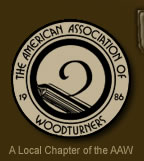Charles Nall: March 23, 2013

Charles Nall demonstrated his techniques for turning hollow spheres, incorporating veneers into his turnings, and decorating turnings with colored leaf designs.

Vase with Maple Leaf Design

Hollow sphere decorated with an African design

Tray with Veneered Rim
Turning a Hollow Sphere

Charles prefers to use a "friction drive" (a cup-type dead center) to turn spheres. He can easily reverse the workpiece so he is always turning right-handed It also minimizes damage when a catch occurs since the workpiece stops before chunks are torn from the wood.

The sphere center and end points are carefully marked on the blank, but the width of the parting cut and depth of the mating recess must also be considered when the end points are marked.

A tenon is turned on each end because a 4-jaw chuck will be used to turn each hemisphere. He made a narrow parting tool from a discarded industrial hacksaw blade and uses it to part the two hemispheres.

Charles prefers to turn spheres inside-out so he can use the inside profile as a guide for cutting the outside. He uses pulling cuts to remove the bulk of the waste from the inside.

He uses a template to be sure that the inside of the sphere is round. A scraper with a negative grind is used to refine the shape so it perfectly matches the template.

Once the inside of the hemisphere is has ben turned, a recess is cut at the rim to eventully hold the mating hemisphere.

He uses a spindle gouge to turn the outside to a uniform thickness. Since the walls are about 1/8" thick, he turns the outside in stages since the finished wall is so thin. He removes enough material at the base to define the shape but leaves enough for strength.

After the two hemispheres are turned and the lip has been cut, he assembles them between centers and turns the bases to 1/4" or less. After both have been turned, they are ready for sanding. Since the walls are so thin, only minimal tailstock and tool pressure can be used.

He separates the hemispheres from their bases with a sharp knife or a bandsaw. If the wood were not dry, he would rough-turn the hemispheres oversize and do the final turning after the wood was completely dry.
Incorporating Veneer

Veneer is most effective on turnings that show minimal grain and figure patterns. He prefers to saw his own veneer since commercial veneer is only 1/40" thick. Thirty degree segments often work well, and the sizes of the segments can be determined from a simple pattern. Circles are drawn on a piece of plywood and radii are drawn at 30 degree increments.

Segments are sawn by hand slightly oversize. He fits and trims the veneer segments to the exact size using a a plane and shooting board. Veneer tape holds the segments together tightly and when a semicircle has been assembled, he sands the edges of the outermost segments with sandpaper on a long board to ensure that the two semicircles join perfectly.

After the entire ring has been joined using veneer tape and the rim of the bowl has been turned flat, the veneer is glued to the rim and clamped until the glue has set. The veneer tape is easily removed by moistening it with water and scraping it from the veneer.
Maple Leaf Design

Once a rough-turned bowl is completely dry, it is ready for finishing. The tenon for the chuck is trued, the rim is turned flat, and the walls are turned to about 3/16" thick. If the design includes piercing, the walls must be thinner.

Natural leaves are selected to fit the area to be decorated and the leaf outlines are traced. Charles uses a Burnmaster "Eagle" woodburning set to burn the pattern. He uses a thin, sharp tip at red heat to burn the design and pierce the wall when appropriate. Burning creates a lot of acrid smoke so good ventilation is required.

Once the entire pattern has been burned on the bowl, the leaves are painted. He buys acrylic pigments from an art supply store and dilutes 1 drop of pigment with 16 drops of water and applies it using a small artists brush. When the paint is dry, a coat of laquer is applied to seal and protect the colors.
by WVWA, a chapter of the American Association of WoodturnersReturn to the Events page

